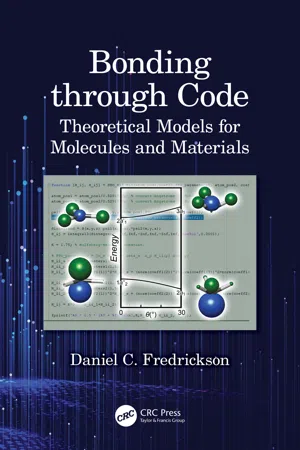
Bonding through Code
Theoretical Models for Molecules and Materials
- 230 pages
- English
- ePUB (mobile friendly)
- Available on iOS & Android
About This Book
This timely and unique publication is designed for graduate students and researchers in inorganic and materials chemistry and covers bonding models and applications of symmetry concepts to chemical systems. The book discusses the quantum mechanical basis for molecular orbital concepts, the connections between molecular orbitals and localized views of bonding, group theory, bonding models for a variety of compounds, and the extension of these ideas to solid state materials in band theory. Unlike other books, the concepts are made tangible to the readers by guiding them through their implementation in MATLAB functions. No background in MATLAB or computer programming is needed; the book will provide the necessary skills.
Key Features
-
- Visualization of the Postulates of Quantum Mechanics to build conceptual understanding
-
- MATLAB functions for rendering molecular geometries and orbitals
-
- Do-it-yourself approach to building a molecular orbital and band theory program
-
- Introduction to Group Theory harnessing the 3D graphing capabilities of MATLAB
-
- Online access to a growing collection of applications of the core material and other appendices
Bonding through Code is ideal for first-year graduate students and advanced undergraduates in chemistry, materials science, and physics. Researchers wishing to gain new tools for theoretical analysis or deepen their understanding of bonding phenomena can also benefit from this text.
About the Author
Daniel Fredrickson is a Professor in the Department of Chemistry at the University of Wisconsin–Madison, where his research group focuses on understanding and harnessing the structural chemistry of intermetallic phases using a combination of theory and experiment. His interests in crystals, structure, and bonding can be traced to his undergraduate research at the University of Washington (B.S. in Biochemistry, 2000) with Prof. Bart Kahr, his Ph.D. studies at Cornell University (2000–2005) with Profs. Stephen Lee and Roald Hoffmann, and his post-doctoral work with Prof. Sven Lidin at Stockholm University (2005–2008). As part of his teaching at UW–Madison since 2009, he has worked to enhance his department's graduate course, Physical Inorganic Chemistry I: Symmetry and Bonding, through the incorporation of new material and the development of computer-based exercises.
Frequently asked questions
Information
CHAPTER 1
The Postulates of Quantum Mechanics
Table of contents
- Cover
- Half-Title
- Title
- Copyright
- Dedication
- Contents
- Acknowledgments
- About the Author
- CHAPTER 1 The Postulates of Quantum Mechanics
- CHAPTER 2 Atoms and Atomic Orbitals
- CHAPTER 3 Overlap between Atomic Orbitals
- CHAPTER 4 Introduction to Molecular Orbital Theory
- CHAPTER 5 The Molecular Orbitals of N2
- CHAPTER 6 Heteronuclear Diatomic Molecules
- CHAPTER 7 Symmetry Operations
- CHAPTER 8 Symmetry Groups
- CHAPTER 9 Group Theory and Basis Sets
- CHAPTER 10 The MOs of H2O
- CHAPTER 11 MOs of the Trigonal Planar Geometry
- CHAPTER 12 Walsh Diagrams and Molecular Shapes
- CHAPTER 13 Getting Started with Transition Metals
- CHAPTER 14 Translational Symmetry and Band Structures
- INDEX